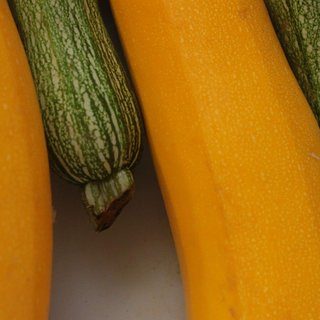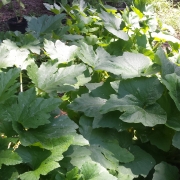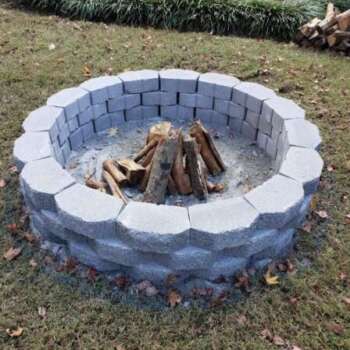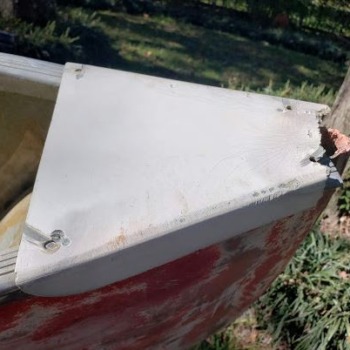
We have always loved growing and harvesting squash, zucchini, pumkin, and watermelon. But for the past 2 years, by mid-June through July, our beautiful plants would suddenly wilt and die. After learning about the Squash Borer moth (Melittia satyriniformissyn.Melittia cucurbitae) with its bright orange body and black wings and the devastation its larvae cause, we were definitely discouraged. The solutions for prevention didn’t sound like something we could (or would) consistently maintain. Wrapping the stalks in aluminum foil or panty hose, catching the moths before they had a chance to lay eggs, inspecting leaves/stems and removing eggs, and using row covers just didn’t sound feasible. Unless we could find a reasonable solution to prevent the situation, we would grow other crops instead. Spraying seemed like the best solution for us, but people reported that they had mixed results. Plus, we didn’t want to do anything that might harm pollinators.
According to the internet, after the Squash Borer moth emerges as pupae from the ground, the adult female moths find vine crops through smell. In our region, this begins around May. The femalesthen lay their eggs on the underside of leaves or at the base of the plant. The eggs hatch in about 7-11 days and immediately burrow into the plant’s stem, where they’ll feed on the stem for 25-27 days.
Our Approach
We knew what ever we needed to do should begin in May, and created a recipe and a plan in consideration ofthe following:
- Neem Oil worked really well at controlling aphids on our roses and clematis plants, so maybe it would work on Squash Borer eggs and hatching larvae.
- And using something to help mask the plants’ scent couldn’t hurt, right?
- The eggs hatch as early as 7 days so we would need to reapply any treatment every 5-7 days.
We began using our experimental recipe in early May. It consists of Neem Oil as an insecticide, a strong herbal oil to hopefully mask the plant’s scent, tobasco sauce as a taste deterrent, and a small amount of detergent to help the mixture stick to the plant. We applied it to the stems and leaves using a 16oz squirt bottle, spraying closely to avoid overspray and taking care to avoid any flowers. We only sprayed late in the early evening, when there were no pollinators flying around. And we repeated this every 5-7 days, or after a heavy rain.
The Results?
It’s too early to say since it’s only been 6 weeks since we started using this method, but…so far, so good. It looks like our efforts are working, and it’s something we’ve been able to maintain despite our busy schedules. We’ve already harvested zucchini and will have some squash ready soon. The plants are huge and we haven’t seen any frass on the stems. (We’ll post updates throughout the season)

Our Zucchini Plants
Late June Update…Some Bad News…
Along with some encouraging news!
Despite everything, each of our plants had squash borer larvae. We found bright orange frass on every stalk, and even multiple locations on a single plant. The plants still looked healthy but would wilt mid-day or during high heat, and then bounce back in the evening. Some exploratory surgery on one of the plants revealed a 1 inch larvae. That means he probably hatched 3 and a half weeks ago. We may have missed spraying that week because of house guestsor, like others, we just had medicore success with spraying. Either way, we had 20+ large plants that we weren’t ready to give up on.
Some of the damaged sections on stalks were really large, and other stalks had multiple borers. Instead of performing surgery on all 20+ of the plants, we figured we’d experiment with a different approach.
Instead of cutting open the stalks and extracting whatever larvae we could find (with a high chance that there could be other larvae we missed), we injected our SMS (Save My Squash) Recipe into and above each stalk section that showed signs of frass. When previously doing “surgery”, it seemed that the larvae would always be chewing away just above the spot where the frass (larvae poop) appeared. Injecting the recipe into the stem 1 inch above the frass was the logical way to getting it on the larvae. And the injections caused a lot less physical damage to the plant than cutting open the stalk and digging out the larvae. Where there werelarge sections of stem damage, we’d also flush it out with the SMS Recipe (Neem Oil also helps fightfungus and rot). We didn’t seal up the damaged sections like we did after surgery; that way we could monitor whether there were signs of fresh frass.
The Enouraging News
Twenty-four hours after doing the “injections”, there were no signs of fresh frass on the majority of the plants. The damaged sections were starting to heal up and look better. We also reinspectedthe stems for any signs of fresh frass in case we missed anything, and retreated as necessary.
In the picture below, this plant is 48 hours “post injection treatment”. It had a 1 inch by 1/2 inch damaged section packed full of orangey, moist frass. We injected the SMS Recipe an inch above the top left side of the damaged area (not visible due to leaf stem), and flushed the large damaged area. The damaged edges of the stem have started to heal and the plant (which is 3 feet in diameter) isn’t showing signs of stress like we would normally see after manually extracting the larvae through “surgery.

Squash Borer Damage After Treatment
So, this may be our preferred larvae removal method from now on. It doesn’t seem to traumatize the plants as much as the surgery method did. We’ll know for sure in a week.
Because Neem Oil is absorbed by the plant (either through the leaves or from the soil by roots) and becomes a systemic insecticide, we’re also going to experiment using a soil drench for squash seedlings before they’re moved to the garden (https://www.discoverneem.com/neem-oil-insecticide.html). But until then, we’ll just have to keep injecting.
If you’d like to try the injection method if you find borers, here’s a list of supplies you’ll need:
- our SMS (Save My Squash) Recipe (see below)
- A marinade injector with only one hole (link to product)
Directions:
Wear hand protection so that you don’t accidentally inject yourself. Fill marinade syringe with SMS recipe and attach needle. Insert the needle into any areas of the stem that have frass and inject/squirt in liquid until it is filled. Approximately 1 inch above the damaged area on the stem, insert the needle (at a 45 degree angle) until you believe you are in the middle of the stalk, retract slightly then inject liquid. The plant’s stem will absorb the neem and the larvae will feed and eventually die.
Note: Neem oil is an insecticide for chewing insect. They eventually die after injesting it (it messes with their hormones). It is not a contact insecticide, meaning that insects don’t die immediately.
Here’s the SMS (Save My Squash) recipe. Definitely let us know if it works for you.
SMS (Save My Squash) Recipe
- 16 oz Squirt Bottle (filled with water)
- 1 1/2 tsp Neem Oil
- 1/4 tsp Basil Oil, Garlic Oil, or Oregano Oil
- 3 drops Dish Detergent (avoid using antibacterial detergent)
- 1/2 tsp Tabasco Sauce (Optional)
In the evening or early morning (before pollinators are active), apply along entire stemand leaves (avoid buds and flowers). Routinely shake bottle in between applications. Re-apply every 5-7 days or after steady rain.
Last Ditch Effort – Emergency Squash Surgery
Last year, we performed “emergency surgery” on many plants that we knew had squash borer larvae. The plants were wilting and there was “frass” (yellowish sawdust-like debris) on the stalk. Using a clean, sharp razor blade, we sliced open the stem, removed the huge larvae, and tightly closed the incision with duct tape. The entire stalk was then covered with soil to encourage new root growth. Many of the plants survived post-surgery, but they did not really thrive. And although we still had a few crops, our harvests wasn’t as rewarding as previous years. But it is definitely an option if you want to attempt to salvage your plant.



